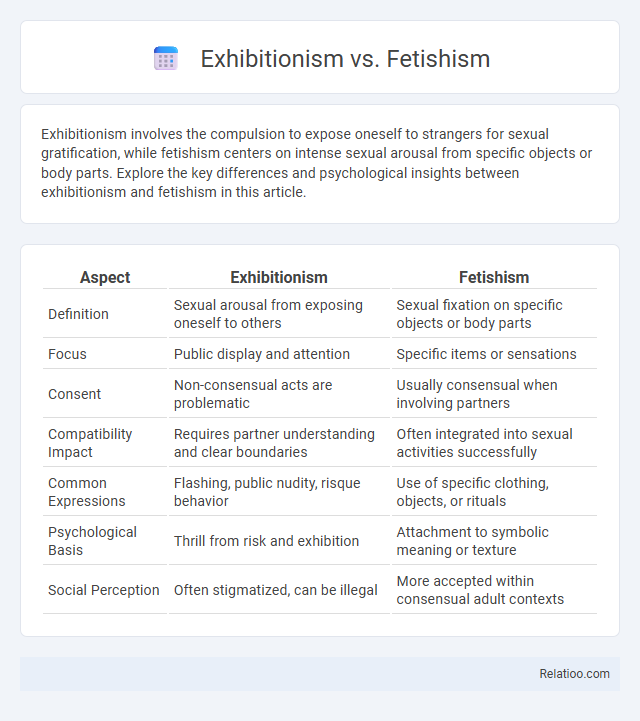Exhibitionism involves the compulsion to expose oneself to strangers for sexual gratification, while fetishism centers on intense sexual arousal from specific objects or body parts. Explore the key differences and psychological insights between exhibitionism and fetishism in this article.
Table of Comparison
| Aspect | Exhibitionism | Fetishism |
|---|---|---|
| Definition | Sexual arousal from exposing oneself to others | Sexual fixation on specific objects or body parts |
| Focus | Public display and attention | Specific items or sensations |
| Consent | Non-consensual acts are problematic | Usually consensual when involving partners |
| Compatibility Impact | Requires partner understanding and clear boundaries | Often integrated into sexual activities successfully |
| Common Expressions | Flashing, public nudity, risque behavior | Use of specific clothing, objects, or rituals |
| Psychological Basis | Thrill from risk and exhibition | Attachment to symbolic meaning or texture |
| Social Perception | Often stigmatized, can be illegal | More accepted within consensual adult contexts |
Defining Exhibitionism and Fetishism
Exhibitionism is characterized by the intense desire to expose one's body or sexual organs to unsuspecting strangers, deriving arousal primarily from the act of being observed. Fetishism involves a deep sexual fixation on specific objects, materials, or body parts, where the fetish becomes essential for sexual gratification. Understanding your tendencies within these definitions helps distinguish between exhibitionistic thrill-seeking and fetishistic object-focus in sexual expression.
Key Differences Between Exhibitionism and Fetishism
Exhibitionism involves deriving sexual arousal from exposing one's body or genitals to others without their consent, often seeking shock or surprise reactions. Fetishism centers on intense sexual fixation on specific objects, materials, or body parts that are not inherently sexual, such as shoes or hair, which become necessary for sexual gratification. The key difference lies in exhibitionism being an outward behavioral act targeting an audience, whereas fetishism is an internalized sexual preference focused on particular stimuli.
Psychological Roots of Exhibitionism
Exhibitionism is rooted in a psychological desire for attention and validation, often stemming from underlying issues such as low self-esteem or a need for control. Fetishism, in contrast, centers on sexual fixation on specific objects or body parts, deriving gratification from these stimuli rather than public display. Your understanding of exhibitionism's psychological roots can help differentiate it from fetishism, highlighting the importance of addressing emotional and cognitive factors in therapeutic settings.
Psychological Roots of Fetishism
Fetishism originates from deep psychological roots involving unconscious associations formed during early psychosexual development, where inanimate objects or specific body parts become linked to sexual arousal. Unlike exhibitionism, which centers on deriving pleasure from exposing oneself to others, fetishism focuses on recurrent fixation on non-living objects or particular materials to achieve sexual gratification. Understanding your fetish can reveal underlying emotional needs or unresolved conflicts embedded in the psyche, highlighting the importance of exploring these behaviors within a therapeutic context.
How These Behaviors Manifest
Exhibitionism manifests through the urge to expose oneself to others for sexual gratification, often driven by a need for attention or shock value. Fetishism involves intense sexual arousal from specific objects, body parts, or scenarios, where the fetish becomes central to Your sexual experience. Unlike exhibitionism, voyeurism centers on deriving pleasure from observing others without their knowledge, highlighting distinct psychological motivations behind each behavior.
Legal and Ethical Considerations
Exhibitionism involves exposing oneself publicly without consent, often violating laws related to public indecency and causing ethical concerns about non-consensual exposure. Fetishism centers on specific objects or body parts and typically occurs in private settings, posing fewer legal issues but requiring mutual consent to avoid ethical breaches. Differentiating between consensual exhibitionism within private contexts and illegal public exposure is crucial to navigating the legal and ethical landscapes surrounding these behaviors.
Impact on Relationships and Social Interactions
Exhibitionism, fetishism, and voyeurism each influence relationships and social interactions uniquely, often shaping intimacy and communication patterns. Exhibitionism involves exposing oneself to others, which can create excitement but may lead to boundary issues if not consensual, affecting trust and respect within partnerships. Fetishism centers on specific objects or scenarios for sexual gratification, potentially enhancing intimacy if shared openly, while voyeurism, characterized by deriving pleasure from observing others, can introduce secrecy and ethical dilemmas that may strain social bonds and personal connections.
Addressing Misconceptions and Stigma
Exhibitionism is often misunderstood as simply seeking attention, but it is a recognized paraphilic disorder involving intense sexual arousal from exposing oneself to unsuspecting others, differing significantly from fetishism, which centers around fixation on specific objects or body parts for sexual gratification. Fetishism is sometimes stigmatized as abnormal, yet many consensual fetish practices are part of healthy adult sexuality, contrasting with the non-consensual nature of exhibitionism which raises legal and ethical concerns. Clarifying these distinctions helps reduce stigma by promoting informed awareness and emphasizing consent, mental health, and the importance of addressing misconceptions in clinical and social contexts.
Treatment Approaches and Therapeutic Options
Treatment approaches for exhibitionism, fetishism, and voyeurism often involve cognitive-behavioral therapy (CBT) aimed at modifying deviant sexual behaviors and underlying thought patterns. Pharmacotherapy, including selective serotonin reuptake inhibitors (SSRIs), may be prescribed to reduce compulsive urges and manage comorbid conditions such as anxiety or depression. Your personalized therapeutic plan should be developed with a mental health professional, integrating behavioral interventions, relapse prevention strategies, and support groups to ensure effective long-term management.
Support Resources for Individuals and Partners
Support resources for individuals navigating exhibitionism include specialized therapy, such as cognitive-behavioral therapy (CBT), and support groups that address impulse control and social boundaries. Partners of individuals exhibiting fetishism benefit from couples counseling and educational programs that foster understanding and communication about specific sexual interests and consent. For exhibitionism and fetishism alike, organizations like the National Coalition for Sexual Health provide access to professional guidance, online forums, and literature to help manage behaviors and strengthen relationships.

Infographic: Exhibitionism vs Fetishism
 relatioo.com
relatioo.com